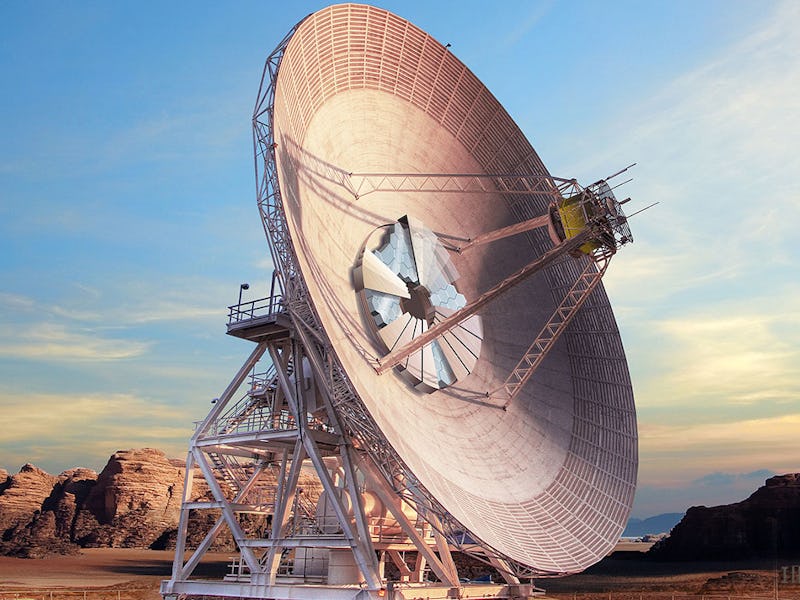Human missions to Mars will use lasers to communicate with Earth — NASA
The new technology is a much needed upgrade for deep-space communication.

Ever since NASA launched the Explorer 1 satellite in 1958, the agency has relied mostly on radio waves to communicate with craft millions — or indeed, billions — of miles across space. But as NASA sets its sight on new destinations for manned missions, it is giving its communications system a much-needed overhaul.
NASA is adding a new dish to its Deep Space Network (DSN), equipped with mirrors and a special receiver to allow it to beam and receive lasers from spacecraft in deep space.
The new antenna dish, dubbed Deep Space Station-23 (DSS-23), is part of a transition to faster, more efficient communication as NASA prepares for a return to the Moon by the year 2024, and sets up for the first human mission to Mars in the mid 2030’s.
The impetus behind the dish is simple: If NASA is to send humans to Mars, they need to be able to communicate with them — and lasers could help ensure future Martian astronauts have good reception 40 million miles from Earth.
Construction of this new era of communications began this week.
Construction of the 112-feet dish began this week in Goldstone, California. It is just one of an array of DSN antennas — bringing the total number of dishes that will help beam laser-borne messages to and from space to 13.
Two similar antennas are currently under construction in Madrid, Spain, too.
Tried and tested
"The DSN is Earth's one phone line to our two Voyager spacecraft — both in interstellar space — all our Mars missions, and the New Horizons spacecraft that is now far past Pluto," Larry James, deputy director of NASA’s Jet Propulsion Laboratory in Pasadena, California, said in a statement .
"The more we explore, the more antennas we need to talk to all our missions," he said.
NASA has used DSN's antennas to communicate with spacecraft since the 1960’s, sending out signals to an average of 30 spacecraft a day. The antennas transmit and receive radio waves between ground-based control and spacecraft. And while radio waves have been working fine all these years, they have serious limitations.
Radio waves tend to grow weaker over long distances, and have limited capacity. For the Voyager twin spacecraft, two spacecraft roaming interstellar space far, far away from Earth, this means that signals to their antennas from Earth — and vice versa — are very weak. In fact, the power that the DSN antennas receive from the Voyager signals is 20 billion times weaker than the power needed to run a digital watch, according to NASA.
Enter, lasers!
Lasers are beams of infrared light. They travel further distances in space with far greater power than do radio waves.
"Lasers can increase your data rate from Mars by about 10 times what you get from radio," Suzanne Dodd, director of the Interplanetary Network, the organization that manages the DSN, said in the statement.
"Our hope is that providing a platform for optical communications will encourage other space explorers to experiment with lasers on future missions," she said.
NASA first tested out laser communication in space in the year 2013, beaming up an image of the Mona Lisa painting to a satellite located 240,000 miles away from Earth.
The famous Leonardo da Vinci painting was divided up into an array of 152 pixels by 200 pixels, and each pixel was converted into a shade of gray represented by a number between zero and 4,095. Each of the pixels was then transmitted by a laser pulse that was fired in one of 4,096 possible time slots.
The painting was then reconstructed by the the Lunar Orbiter Laser Altimeter (LOLA) instrument onboard the Lunar Reconnaissance Orbiter based on the arrival times of each laser pulse.
"This is the first time anyone has achieved one-way laser communication at planetary distances," LOLA's principal investigator David Smith of the Massachusetts Institute of Technology, said in a statement at the time.
"In the near future, this type of simple laser communication might serve as a backup for the radio communication that satellites use," he said. "In the more distant future, it may allow communication at higher data rates than present radio links can provide."
Laser beam-based communication will be put to the test in the year 2022, when NASA launches its Psyche mission, which will travel to study a metal asteroid orbiting the Sun between Mars and Jupiter.
The orbiter will carry a test laser-communication terminal onboard, designed to transmit data and images to an observatory at Southern California's Palomar Mountain. For the future of human space travel to stay on track, let's hope it works.